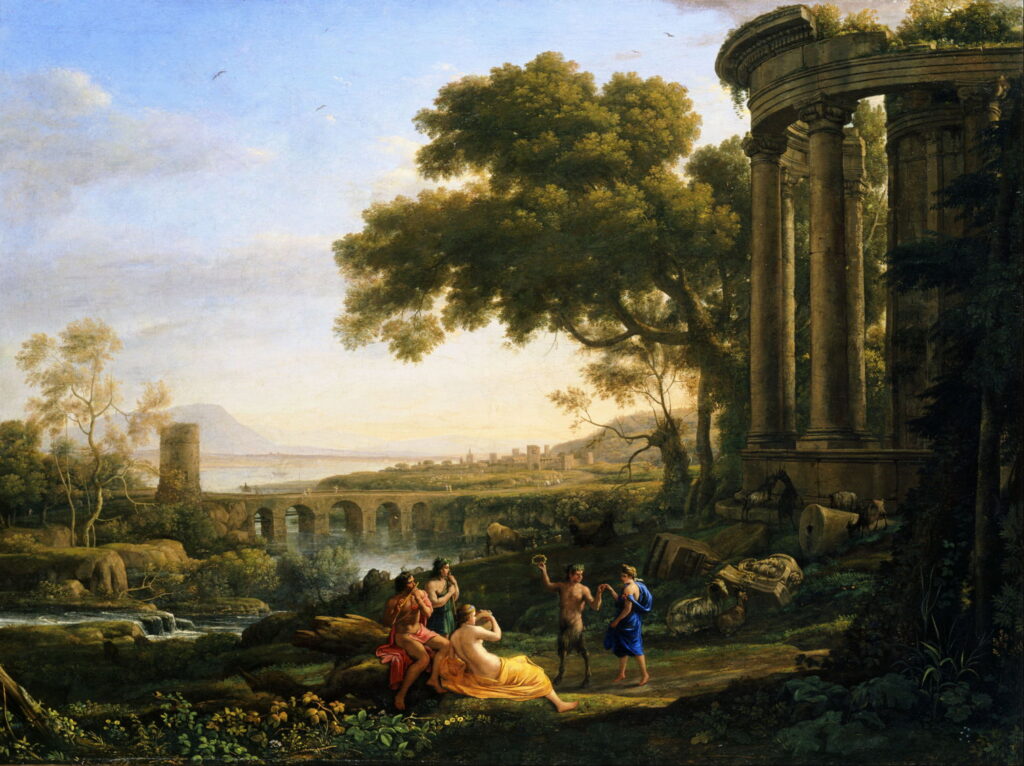A French landscape painter in Rome: Claude

Nicolas Poussin’s pure landscape paintings developed from settings of myths. The other French founding father of landscape painting, Claude Lorrain (1604/5–1682), drew from art imported from Northern Europe to Italy in the early seventeenth century. One of the key figures in this change in the south was the Flemish artist Paul Bril, who moved to Rome around 1582. Although he found plenty of demand there for mythological scenes, he also painted some pure landscapes.
Paul Bril (c 1553/4–1626), View of the Roman Forum (1600), dimensions not known, Gemäldegalerie Alte Meister, Staatliche Kunstsammlungen Dresden, Germany. Wikimedia Commons.
Bril’s superb View of the Roman Forum from 1600 shows livestock wandering across what had been the very centre of life in classical Rome, with the remaining columns of the temples of Castor and Pollux, and Hadrian’s Basilica. The figures are lifelike, and engaged in everyday activities, excellent staffage bringing the whole view to life.
Paul Bril (c 1553/4–1626), View of Bracciano (c 1622), oil on canvas, 74.5 x 163.6 cm, Art Gallery of South Australia, Adelaide, South Australia. Wikimedia Commons.
His panoramic View of Bracciano from about 1622 is strongly Italianate, but a painting ahead of its time. It’s a fairly faithful depiction of a real place, with all sorts of fascinating little scenes within it, like the young boy doffing his hat to the passing dignitary in their coach with an armed guard.
Bril balances this view between its subject on the left, and the deep view over the town’s volcanic lake on the right, where there’s greater foreground action in the form of the approaching coach. This asymmetric and less formal balance helps make it look more faithful to reality, and less an artificial construction.
It’s thought that one of Bril’s pupils when he was in Rome was Agostino Tassi, who in turn taught Claude Lorrain, whose original family name was Gellée. Claude may have been orphaned, although that’s disputed, and travelled to Italy in his early teens, where he ended up being employed in Tassi’s household as a servant and cook.
During his employment with Tassi, the artist taught Claude to draw and then paint, and moved him from the kitchen to his busy workshop, then very active making frescoes in palaces. Altogether, Claude probably worked there between about 1622-25. After further training, perhaps back in the Vosges, then part of the Duchy of Lorraine, Claude returned to Rome to paint in his own right in about 1626 or 1627, just after Paul Bril had died there.
Claude Lorrain (1604/5–1682), Capriccio with Ruins of the Roman Forum (c 1634), oil on canvas, 79.7 x 118.8 cm, Art Gallery of South Australia, Adelaide, South Australia. Wikimedia Commons.
One of Claude’s early paintings shows an almost uncanny link with Bril: Capriccio with Ruins of the Roman Forum from about 1634. Compare that with Bril’s View of the Roman Forum from over thirty years earlier. Claude opts for repoussoir only on the right, and lights his version richly, otherwise his composition is similar.
Claude Lorrain (1604/5–1682), An Artist Studying from Nature (1639), oil on canvas, 78.1 x 101 cm, Cincinnati Art Museum, Cincinnati, OH. Wikimedia Commons.
By the end of the 1630s, Claude’s reputation was made. Like Poussin, he drew and sketched in front of the motif, a practice he showed in An Artist Studying from Nature (1639). This is another asymmetric and informal view, reversing the composition of Bril’s View of Bracciano, putting the castle on the right to balance the foreground and distance on the left. Once again, Claude bathes it with rich golden light.
Claude Lorrain (1604/5–1682), Landscape with Nymph and Satyr Dancing (1641), oil on canvas, 99.7 x 133 cm, Toledo Museum of Art, Toledo, OH. Wikimedia Commons.
Of course paintings like his Landscape with Nymph and Satyr Dancing (1641) weren’t made outdoors, but assembled from his library of sketches which had been made in front of the motif. This is a good example of van Mander’s principles of composition at work, with the group of figures in the centre foreground, low so that they don’t distract from the more distant view along the coast of an estuary.
Claude Lorrain (1604/5–1682), Embarkation of St Paula (after 1642), oil on canvas, 50.5 x 39 cm, Dulwich Picture Gallery, London. Wikimedia Commons.
Claude does seem to have tipped his hat in the direction of his master Tassi in his maritime paintings, such as the Embarkation of St Paula. This follows the format for which Claude is most famous: a view along a river opening out to the distant sea, with towering classical buildings on both banks, giving it great depth and drawing the eye from its foreground figures to the low sun. Unlike the majority of landscape paintings, Claude orientates his canvas into the ‘portrait’ mode to accommodate the buildings.
Nearly two centuries later, the English landscape artist JMW Turner was a great admirer of Claude’s work.
Joseph Mallord William Turner (1775–1851), The Decline of the Carthaginian Empire … (1817), oil on canvas, 170.2 x 238.8 cm, The Tate Gallery (Turner Bequest 1856), London. Photographic Rights © Tate 2018, CC-BY-NC-ND 3.0 (Unported), https://www.tate.org.uk/art/artworks/turner-the-decline-of-the-carthaginian-empire-n00499
In 1817 Turner painted his Claudean Decline of the Carthaginian Empire looking straight into the setting sun.
Joseph Mallord William Turner (1775–1851), The Harbour of Dieppe (c 1826), oil on canvas, 173.7 x 225.4 cm, The Frick Collection, New York, NY. Wikimedia Commons.
Many of Turner’s paintings are similarly contre-jour, such as this view of The Harbour of Dieppe from about 1826. Turner’s landscapes were firmly rooted in the many sketches he made in front of the motif, but he faced similar challenges to those of both Claude and Poussin in painting finished works in the studio.



